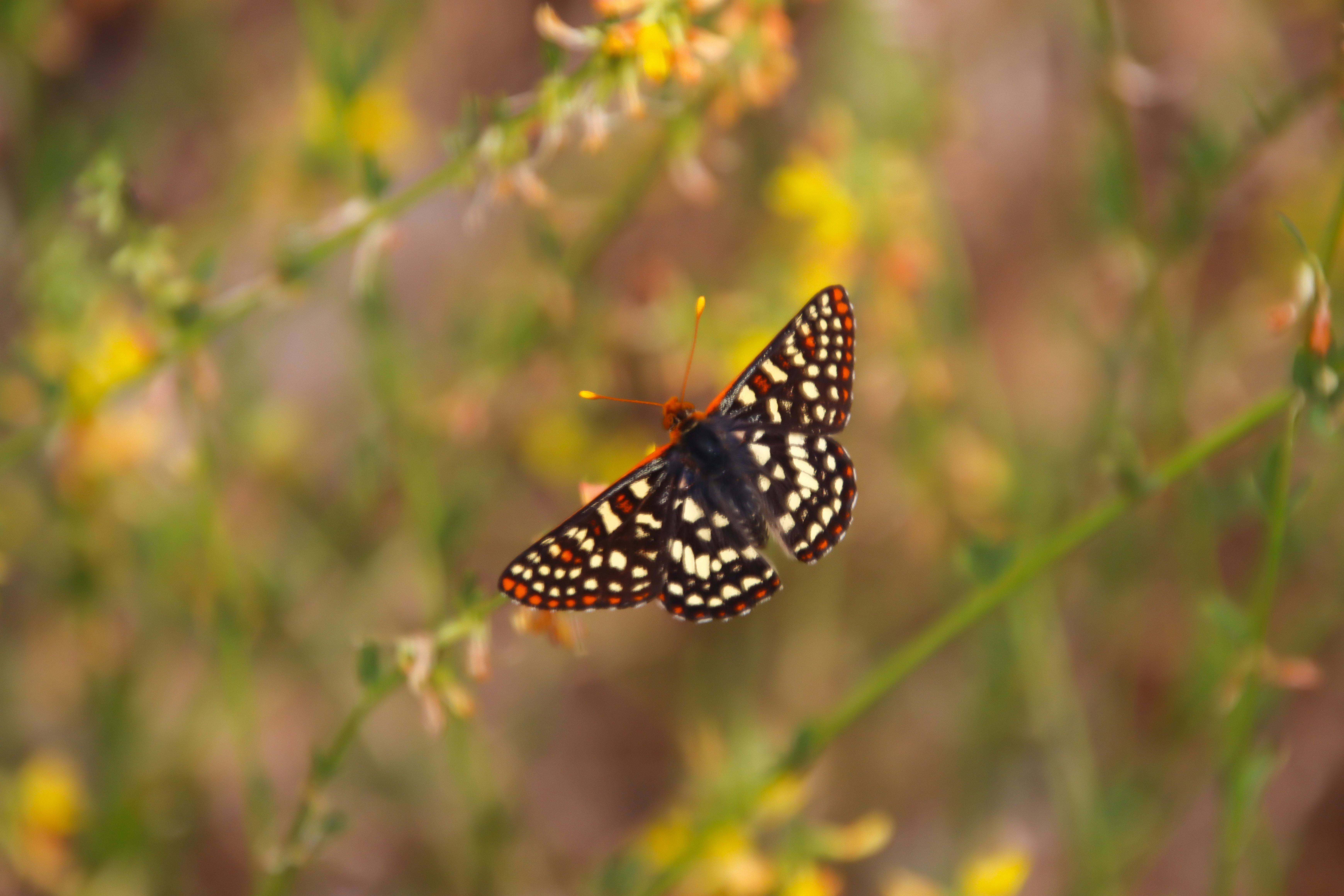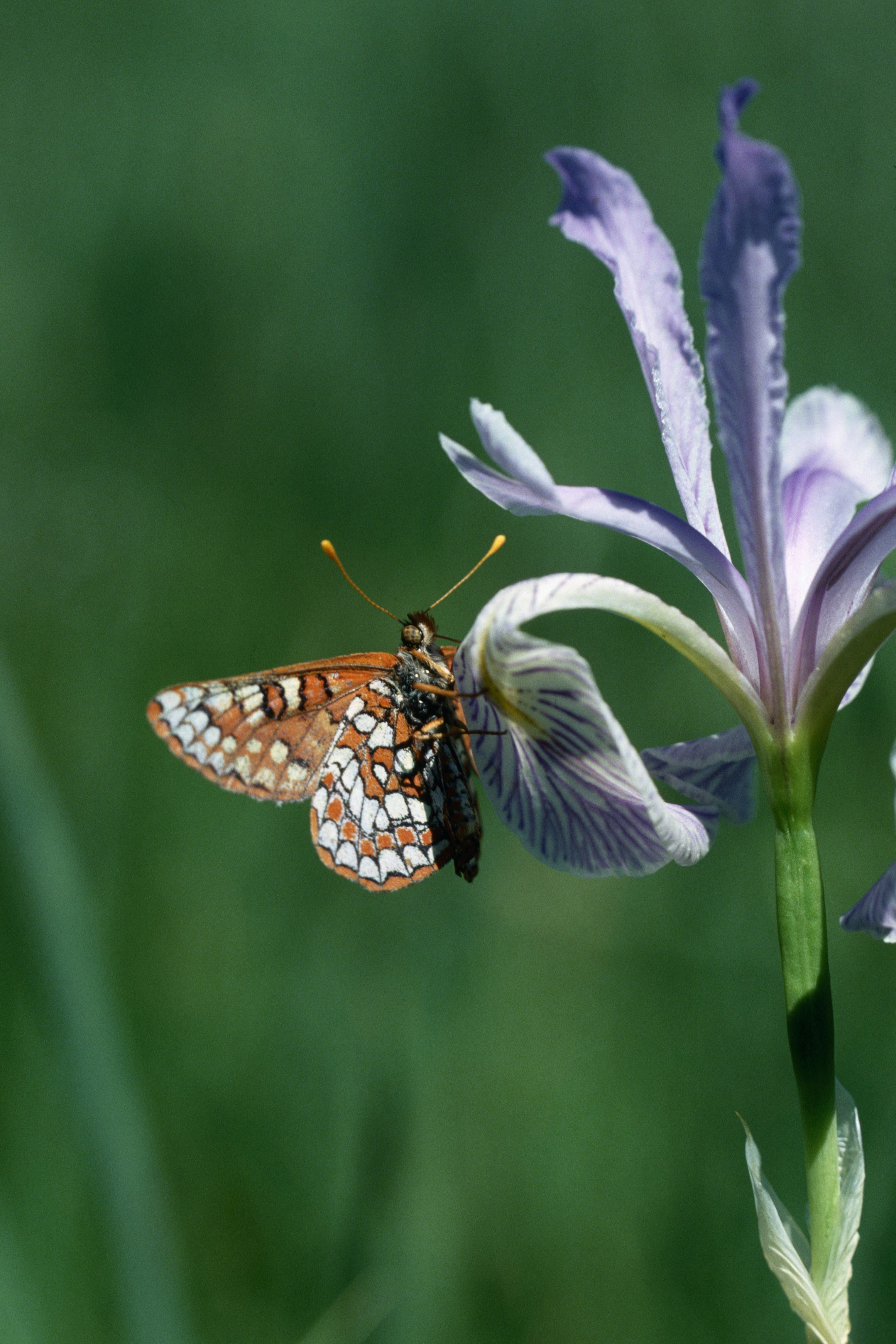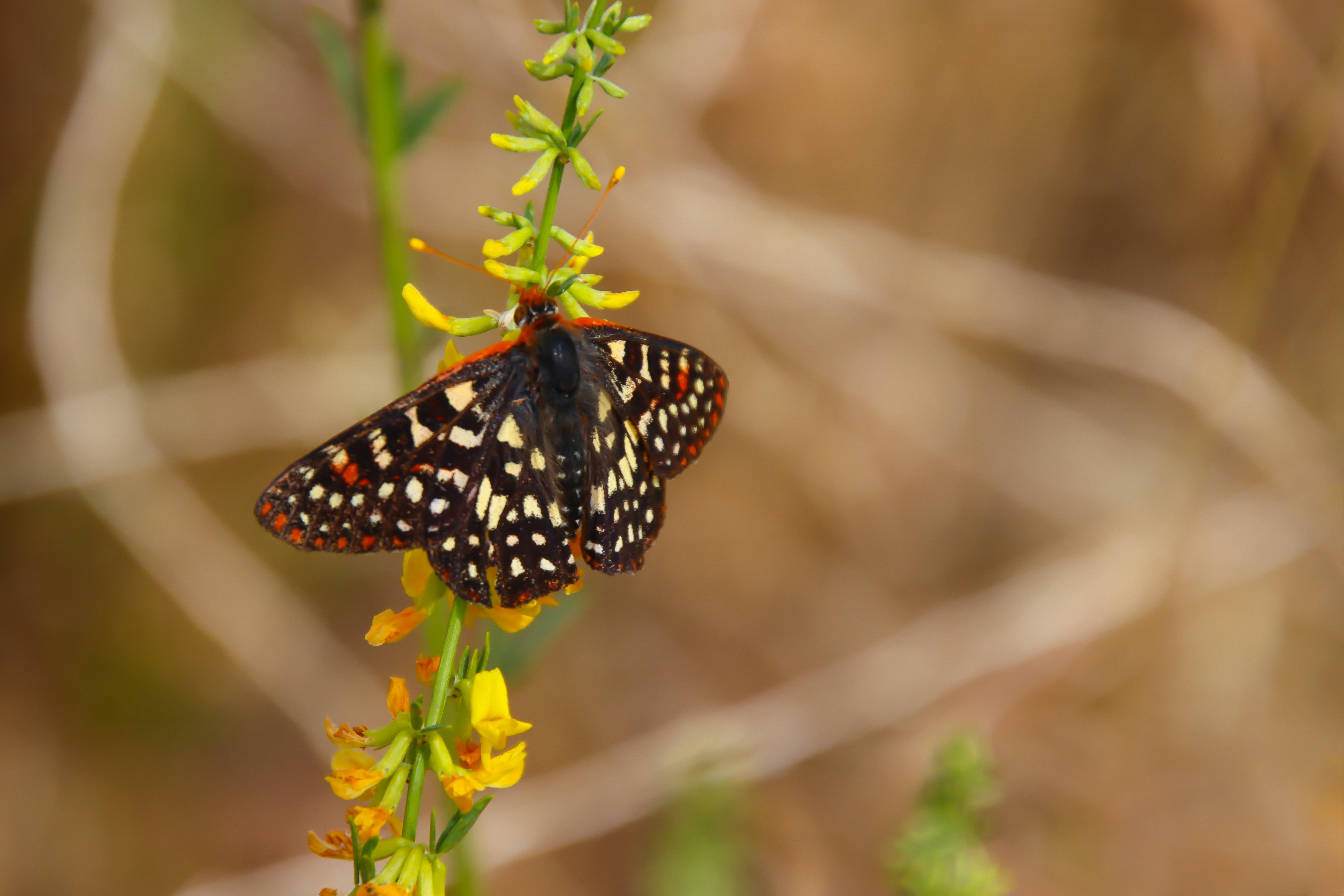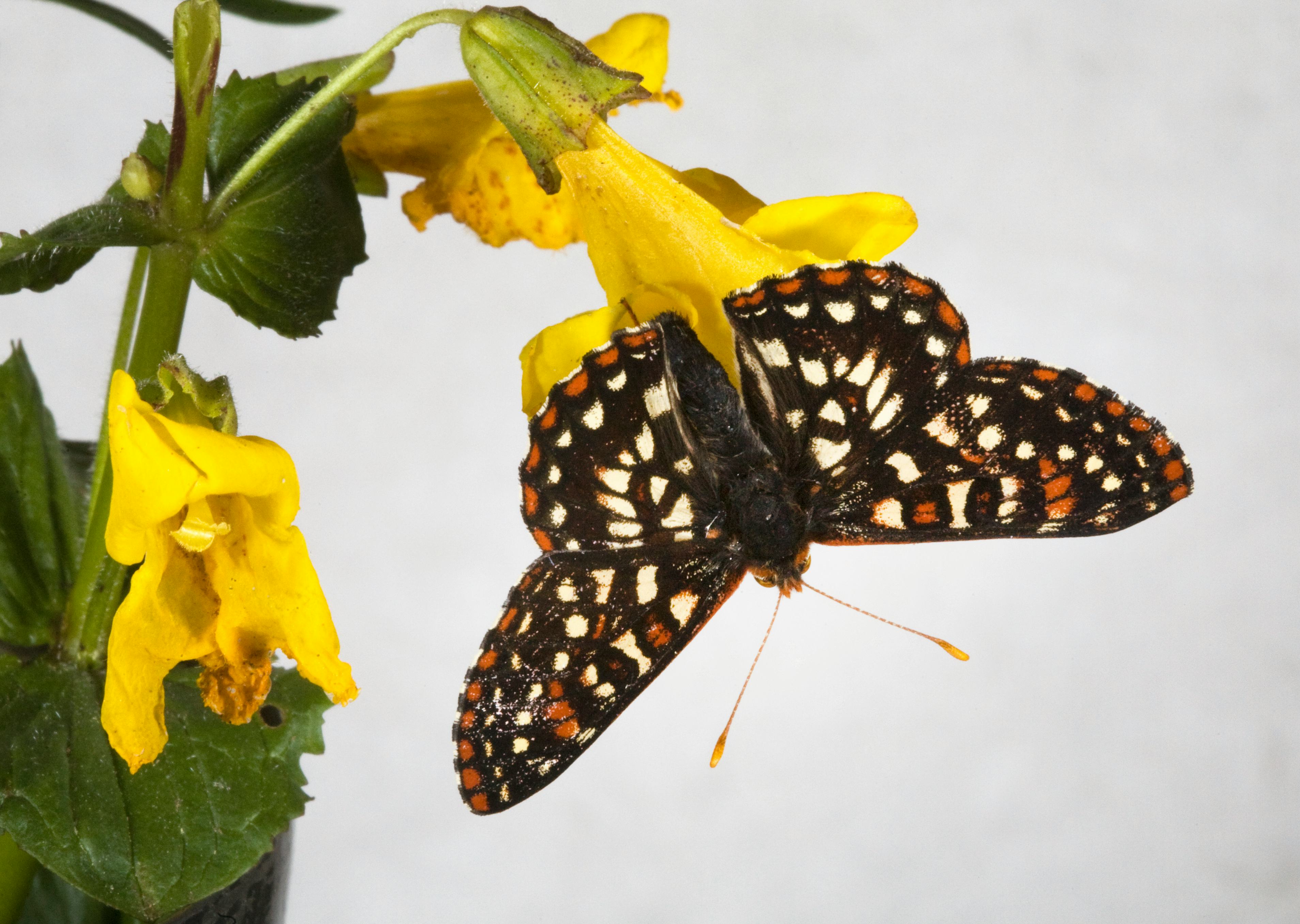
Some butterflies cover enormous distances to find the environments that best suit their needs. But not Edith’s checkerspot. Named for the checkered color pattern on its wings (and, it’s assumed, for an unknown woman named Edith), this North American butterfly (Euphydryas editha) is an unusually sedentary species. Generation after generation, populations of checkerspots, tend to stay in the same spot, close to a stand of their favorite food plant, be it paintbrush, owl’s clover, plantain, or something else.
This homebody behavior has allowed populations of the butterfly to adapt well to local circumstances. Every year, individuals better suited to their corner of the world are more likely to survive and produce more offspring — giving rise to great regional variation among this species in terms of appearance, behavior, and host plant preference. Some are now considered separate subspecies.
But as the planet’s climate changes, this hyperlocal adaptation may put checkerspots at risk. If, for example, rising temperatures cause the climatic comfort zone of the species to shift northward (or if in the mountains, uphill), populations living far south or at the bottom of a valley may perish. And because the species doesn’t move around much, butterflies may not be able to move into more suitable habitat that is opening up.
On the other hand, if at least some butterflies do stray from home, all of the local adaptation that’s taken place means that, for the species, there’s a lot of variation for natural selection to work with.
What will be the fate of the checkerspot as temperatures keep going up and extreme weather becomes more common? Will it manage to move — or will it die out? The type of long-term data needed to answer these kinds of questions often doesn’t exist for the species that researchers and conservationists worry about. But for Edith’s checkerspot, it does — thanks, in no small part, to two devoted biologists.
For decades, evolutionary ecologist Michael C. Singer and his colleague and spouse Camille Parmesan, a climate change biologist, have been tracking the fate of dozens of North American checkerspot populations — Singer since the late 1960s, as he describes in a recent autobiographical paper in the Annual Review of Entomology, and Parmesan since 1982. In the early 1990s, Parmesan realized that climate change was putting the species at risk. “Very few population biologists and ecologists were working on climate change at the time,” she recalls. “It just wasn’t in people’s mindset.” Today, of course, it very much is — and the disparate fates of some of the populations the couple has studied hold important lessons for ecologists and conservationists alike.
Trouble down south

To learn what had been happening to the checkerspot as the world steadily warmed, Parmesan spent several years in the 1990s collecting old records of checkerspot sightings, some dating back to the 19th century. Together with Singer, she checked them against current populations across North America. This revealed a clear pattern. “They seemed to be going extinct a lot in Mexico and not in Canada,” she says. “And they seemed to be going extinct a lot at low elevations and not at high ones.”
This trend suggested that as temperatures increased, the species’ southern distribution was shrinking, with populations disappearing when it got too hot. But were they also expanding northward? Other butterflies were, as Parmesan and European colleagues learned by studying historic and current ranges of 35 other species. Repeatedly, researchers saw southern populations going extinct and new populations appearing up north. Evidently, global warming was creating more favorable conditions where it used to be too cold and less favorable ones where it had always been nearly too hot. The same was subsequently found for many other species, as Parmesan described in a widely cited 2006 overview.
The case for checkerspots was far less clear because the remote northern parts of their historical distribution, in the Canadian Rockies, have long been underexplored — for understandable reasons. “One of these sites took us a 25-mile hike to get there,” Parmesan says. “Other sites that I’ve never been to our two- and three-day backpacking hikes.”
Parmesan and Singer, who are now at the Theoretical and Experimental Ecology Station in Moulis, France, continued to regularly visit and assess over a dozen more accessible Edith checkerspot populations. And they found that the stories playing out at each site were strikingly different.
Three populations, in particular, have taught them that in the face of other evolutionary pressures — both natural and man-made — responses to a changing climate are far from straightforward or predictable.
It’s getting hot down here
At a dry granite outcrop on the slopes of the Sierra Nevada in Sequoia National Park, Singer and Parmesan found that the subspecies of Edith’s checkerspot living there is facing a dilemma. If females lay their eggs too high up on the local lousewort plants, those eggs risk ending up in the stomachs of grazing animals. But if they lay the eggs too close to the bare soil, on sunny days, it might get so hot near the ground that the developing larvae die inside the eggs.
As temperatures at the site continue to rise, that balancing act will become increasingly tricky. In the summer of 2022, Parmesan and Singer measured the temperature at the average height where checkerspots lay their eggs — around one-sixth of an inch above the ground. Temperatures at that height exceeded 118°F, they found. “We know from lab work that is enough to kill all of the eggs,” Singer says.
Yet until recently, the checkerspots had shown no sign of adapting to lay their eggs higher up the lousewort plant, presumably because of the danger of grazers. To Singer and Parmesan, this illustrates that adapting to climate change may often not be as straightforward as it seems and that even at the center of a species’ range, animals may be exposed to temperatures that are close to the limit of what they can tolerate.
Fortunately, the checkerspots at the site are laying far more eggs than the vegetation could support anyway if all the eggs hatched into caterpillars. One lousewort plant can perhaps survive two or three clutches of around 40 eggs each, but in this spot, plants may carry up to nine clutches. If some of those eggs die, it hardly affects population numbers at all.
But alas, producing an overabundance of eggs has not saved all checkerspot populations.
Death in the hills
At Jasper Ridge in the coastal hills surrounding San Francisco Bay, a population of the Bay checkerspot, a threatened subspecies of Edith’s checkerspot, had been entirely wiped out by the early 2000s. These butterflies had been living life on the edge for decades: As far back as the early 1970s, Singer and colleagues had been surprised to find that each year, most of the caterpillars — some 80 percent — didn’t find any food at all and those that did rarely found enough. Around 98 percent of them starved.
This happened because, unlike the persistent lousewort plants in Sequoia National Park, many of the Indian paintbrushes and California plantains the caterpillars at Jasper Ridge fed on died long before the larvae had eaten enough to build reserves to survive the dry summer.
One would think that under such circumstances, female checkerspots would evolve to mature and lay their eggs earlier in the season before food plants died. But surprisingly, Singer found, they had actually evolved to do the opposite: mature later.
To find out why that might be, Singer took his data on how the laying date affected the likelihood that caterpillars would die and compared it with data collected by colleagues. One of them had documented the speed with which caterpillars gained weight. Another had found that for every extra milligram of weight that a female butterfly gained, she could lay two extra eggs.
From these strands of information, Singer landed upon this stark truth: It was worth it for females to delay reaching adulthood, even if this increased the risk that individual offspring would starve. Delaying a female's maturation by a week might, under the best possible circumstances, increase the number of eggs she laid by almost two-thirds. Delaying maturation by three weeks could more than triple her egg count. Laying eggs earlier was safer, but the potential payoff was much lower.
The Bay checkerspot somehow managed to hang on until the early 2000s — it hasn't been seen since at Jasper Ridge. A modeling study by another team of scientists proposed how climate change finished it off. "The variability in rainfall increased, giving rise to severe droughts as well as floods," Parmesan says. "These extremes must have pushed them over the edge." Droughts caused plants to die even earlier, turning the Bay checkerspot's risky strategy into a suicidal one. But the biggest problem, the model showed, may have been a series of unusually cloudy springs during which it was often too cold for caterpillars to feed or grow.
A dangerously seductive intruder

The fate of a third population living high up in the Sierra Nevada, in Schneider's Meadow near Carson City, Nevada, was described in the journal Nature in 2018 (and inspired this creative video). Checkerspots there had long been struggling with some of the same issues as the butterflies at Jasper Ridge — and females in this population had also evolved to lay their eggs late in the season in order to produce more eggs. This meant that their caterpillars, too, died in great numbers when the blue-eyed Marys (Collinsia parviflora) they were feeding on withered away before they had had enough to eat.
But then an exotic new plant species showed up in the meadow — the English plantain, Plantago lanceolata, which remained nice and juicy far longer than the native ones. The local checkerspots were quick to shift, evolving a clear preference to lay their eggs on the intruder. In 1982, only about 5 percent of checkerspots at the site preferred English plantain. By 2005, they all did.
This allowed the checkerspots at Schneider's meadow to thrive — until the death of Harry Schneider, the owner whose family gave their name to the meadow. Now that his cows were no longer grazing there, grasses grew freely and covered the lowly plantains to the point that the microclimate around the plantains became too cool and damp for caterpillars to survive. The checkerspot population soon disappeared: Their switch in preference to an exotic newcomer had done them in.
The lesson: Even when animals do successfully adapt to the changes brought about by human beings, they might be painting themselves into a corner.
But in this case, there’s a happy ending, for now: The meadow was eventually recolonized by a few unusually adventurous checkerspots flying in from elsewhere. Those newcomers had a healthy preference for blue-eyed Marys, which were still in full supply and, thankfully, tended to grow in drier spots where the grass never gets quite as high. Checkerspots are back at Schneider’s Meadow, although they are — once again — living life on the edge.
No one is safe from climate change

Three populations, none of them anywhere near the margins of the species distribution. All are trying to find a balance between the pressures affecting their survival and reproduction, and all are confronted with man-made change, climate change very much included.
While one of them, on a dry outcrop in the Sierra Nevada, has been able to hang on, the other two went extinct, and only one of these was replaced by a population more suited to the new situation.
Where are checkerspots headed? Not even decades of study provide easy answers. But Singer and Parmesan believe their findings hold important lessons, both for their favorite butterflies and for conservation in general. The most crucial one, Parmesan says, is that in the face of climate change, even populations at the heart of a species’ range may be living on the brink. “Conservationists often think that if you’re in the interior of the range, you’re OK. We’re saying: Don’t assume that,” she says.
Studies like Singer’s and Parmesan’s have also inspired novel kinds of conservation efforts. On San Bruno Mountain near San Francisco, conservationists have tried manually depositing caterpillars on the exotic English plantains to try to force a shift. “We’ve had some success,” says Stuart Weiss, chief scientist at Creekside Science, a center of conservation expertise involved in the efforts. Four generations of checkerspot larvae have been documented at the site since Bay checkerspots were released there, many of them munching away on English plantains. (Unfortunately, Weiss doesn’t think doing the same thing at Jasper Ridge would help bring back that population because there aren’t enough English plantains there.)
A pilot study at San Bruno Mountain is also testing whether cattle can help to suppress wild oats and other invasive exotics that have colonized the area and choked out the growth of plantains and other plants caterpillars use for food.
There is debate in conservation circles on how drastic interventions should be. For example, as climate patterns shift, should conservation workers move checkerspots to promise new habitats — even if they didn’t exist there historically? “I would say yes,” says Parmesan. “I absolutely think we should be moving them around.”
And she’d go further. An endangered subspecies called the Quino checkerspot lives down in Mexico and Southern California, hundreds of miles away from the Bay Area — and it’s in trouble. “That subspecies will go extinct because of urban sprawl and climate change,” Parmesan says. “I argue that we should move those up to the Bay Area. But people are horrified when I say that, and the US Endangered Species Act won’t allow it.” This is because conservationists worry that closely related subspecies like the Quino and Bay checkerspot might interbreed and hybridize when moved into the same location, compromising the genetic integrity of each.
Parmesan agrees this might happen but counters that the two subspecies would produce fertile offspring — thus preserving more genetic diversity than would remain if either of them went extinct and increasing the species’ potential to adapt to new situations. When the Bay Area gets too hot for the Bay subspecies, she says, the genes it would acquire from interbreeding with the heat-adapted Quino subspecies might prove very welcome.
Singer and Parmesan emphasize that diversity is key: A variety of landscapes and kinds of vegetation, with a multitude of locally adapted species and subspecies, provide the best insurance for the future. Some populations may adapt, others will perish — and the more diverse the cast of characters, the higher the chance that some will make it.
But there is no guarantee that such diversity will be enough — either for Edith’s checkerspot or for other vulnerable species, says Parmesan, who was a coordinating lead author on the latest report of the Intergovernmental Panel on Climate Change on impacts and adaptation. “The impacts are so much worse than most people think,” she says. “Every taxonomic group is being affected. We’ve got to do what we can to try to preserve the most life that we can.”
This article originally appeared in Knowable Magazine, an independent journalistic endeavor from Annual Reviews. Sign up for the newsletter.







